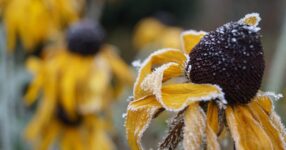One of these fall weekends, you might be inclined to pick up a rake or leaf blower and clean out your garden beds, removing fallen leaves and dead plants. Don’t do it.
While it’s tempting to make everything look nice and tidy for winter, resist the urge. This is your golden opportunity to help wildlife get through winter.
Those dead stalks, withered foliage, twigs and fallen leaves may look messy to you, but they will be the winter home for thousands of pollinators and beneficial insects, spiders, frogs, and other creatures. The dried seedheads of your native plants are a vital food source for birds.
So many animals and insects rely on our gardens for food and shelter year-round, not just while the plants are green and growing.

Many native solitary bee species overwinter in the hollow stems of dead plants.
Shelter Pollinators, Beneficial Insects, and Other Bugs
As the months get colder, most insects won’t be looking for food, but for protection from the weather. Letting fallen leaves stay where they are and leaving dead plant material standing until spring gives them lots of hideouts to wait out the winter.
Butterflies and moths, for example, have evolved many strategies to survive the cold. They overwinter as caterpillars, as grown butterflies, as eggs, and as larvae. Besides chrysalises and cocoons they shelter in rolled up leaves, on twigs, underneath bark and in crevices, in seedpods, even in the soil.
Solitary bees, like mason and leaf-cutter bees, search out the hollow stems of native perennials and grasses. Other bee species seek out cavities or holes in wood, especially fallen logs and snags. Some head underground to sleep.
Many insects and amphibians, such as frogs and salamanders, need a thick layer of fallen leaves to provide cover, both from the elements and from predators.
This dead material serves another purpose: It protects the soil from erosion, keeping it from washing away during storms. At the same time, it slowly decomposes, adding nutrients to the soil.

Goldenrod seeds attract many species of birds, including goldfinches, juncos, and Carolina wrens.
Feed the Birds
Birds eat the seedheads of flowering perennials and grasses throughout winter, particularly native plants. Indigo buntings, chickadees, titmice, and sparrows eat sunflower seeds. Nuthatches and cardinals like asters. Goldfinches, Carolina wrens, and juncos eat the seeds of goldenrod.
Other plants to leave standing include the faded flowerheads of coneflower, black-eyed Susan, Joe Pye weed, ironweed, bee balm, hyssop, blanket flower, blazing star, penstemon, and mountain mint.
Birds will also find and eat insects that have burrowed into plant stems or are hidden among fallen leaves.
When to Rake and Remove
There are instances when removing leaves and other dead plant material does makes sense. Diseased or insect-infested plants should always be cut down and taken out of the garden.
Matted leaves on your lawn can smother and kill grass. Gather them up and use them as mulch in other areas of the garden. Dig them into the soil of your empty vegetable beds, or add to a compost pile.
Another reason to rake a thick pile of leaves off of an area is when there are spring-flowering bulbs planted underneath, especially little bulbs, like snowdrops and crocus, that would struggle to break through the mats. Help those bulbs by raking and shredding the leaves, then spread them back on the bed as mulch.
If you can’t bring yourself to let your entire garden look unkempt, clean up the areas that bother you the most, and leave those that are out of view or further from the house undisturbed.
When is it time to finally cut things down and clear them out? In Pennsylvania, mid- to late-April, or once daytime temperatures stay above 50 degrees F for seven consecutive days. If you can’t wait that long, protect the insects that haven’t yet emerged by gently gathering the leaves and brush and putting it in an out-of-the-way place for another month, or until night temperatures are consistently above 50 degrees.





